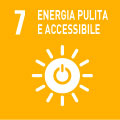- Docente: Marco Giacinti Baschetti
- Crediti formativi: 6
- SSD: ING-IND/24
- Lingua di insegnamento: Inglese
- Moduli: Marco Giacinti Baschetti (Modulo 1) Carmine D'Agostino (Modulo 2)
- Modalità didattica: Convenzionale - Lezioni in presenza (Modulo 1) Convenzionale - Lezioni in presenza (Modulo 2)
- Campus: Bologna
- Corso: Laurea Magistrale in Ingegneria per l'ambiente e il territorio (cod. 8894)
-
Orario delle lezioni (Modulo 1)
dal 17/02/2025 al 09/06/2025
-
Orario delle lezioni (Modulo 2)
dal 02/04/2025 al 16/04/2025
Conoscenze e abilità da conseguire
At the end of the course the students will have a thorough knowledge of the basics of Carbon Capture and Storage (CCS), an important driver of environmental governance issues of developed Countries. Spiraling from carbon cycle activity and analysis of greenhouse gases effect on global climate, the students will see how CCS could be an important mitigation strategy for carbon emissions. They will learn the main capture technologies for CO2 control and reduction including the cost issues related to the different solutions. In addition, they will investigate the main criticalities related to transport and storage of captured CO2 with particular reference to the important features of the geological sites suitable for long term storage and possible use of CO2 injection to improve oil and gas extraction.
Contenuti
Introduction on the problem of global warming
• Greenhouse effect: physical principle and main effects on hearth climate
• CO2 and other greenhouse gases
• Causes and effects of global warming
Approaches to mitigating global warming
• Political aspects from Kyoto to COP21 (up to 26)
• Legislation (EU Emissions Trading System (ETS))
• Specific actions
The Carbon Capture
• Approaches to capture: definition and application of pre Combustion, post-combustion and/or oxyfuel capture, alternative approaches (chemical looping)
• Separation technologies applied to CCS (cryogenic membrane adsorption absorption)
• The chemical looping
• The costs of the CCS
Hard to abate sectorss
• CCS and renewables energies: definition of hard to abate sectors
• Description and structure of typical hard to abate the processes cement factories, steel mills, chemical industries etc)
• Examples of specific approaches to capture and case studies.
The transport (and storage) of CO2
• Properties of CO2, characteristics of the streams for transport and storage applications
• CO2 Transport technologies and features (ship and/or pipeline)
• CO2 Storage (characteristic of the sites and possible issues)
Testi/Bibliografia
The course will be based mainly on the materials (slide papers and reviews) that the professors will made available to the students.
Metodi didattici
Lessons in presence with the help of slides and other materials
Modalità di verifica e valutazione dell'apprendimento
The assessment of the course will be based on an oral inteview on the different topics considered during the course. At least two questions will be asked for the oral which can focus on both theroatical aspects and example of applications.
Depending on the number of students the possiblity to substitute the oral of one of the modules with a written essay on the a thematic chosen by the professor will be considered at least for one of the course modules.
The final grade will be decided by the professors starting from the average grade of the two modules weighted on the number of credits.
Strumenti a supporto della didattica
Slides and other teaching material given to students by the professor
Orario di ricevimento
Consulta il sito web di Marco Giacinti Baschetti
Consulta il sito web di Carmine D'Agostino
SDGs



L'insegnamento contribuisce al perseguimento degli Obiettivi di Sviluppo Sostenibile dell'Agenda 2030 dell'ONU.
